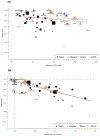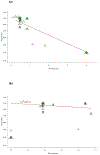Association Between Triglyceride Lowering and Reduction of Cardiovascular Risk Across Multiple Lipid-Lowering Therapeutic Classes: A Systematic Review and Meta-Regression Analysis of Randomized Controlled Trials
- PMID: 31530008
- PMCID: PMC6791781
- DOI: 10.1161/CIRCULATIONAHA.119.041998
Association Between Triglyceride Lowering and Reduction of Cardiovascular Risk Across Multiple Lipid-Lowering Therapeutic Classes: A Systematic Review and Meta-Regression Analysis of Randomized Controlled Trials
Abstract
Background: Randomized trials of therapies that primarily lowered triglycerides have not consistently shown reductions in cardiovascular events.
Methods: We performed a systematic review and trial-level meta-regression analysis of 3 classes of lipid-lowering therapies that reduce triglycerides to a greater extent than they do low-density lipoprotein cholesterol (LDL-C): fibrates, niacin, and marine-derived omega-3 fatty acids. Key inclusion criteria were a randomized controlled trial that reported major vascular events. We also incorporated data from a previous meta-regression of 25 statin trials. The main outcome measure was the risk ratio (RR) for major vascular events associated with absolute reductions in lipid parameters.
Results: A total of 197 270 participants from 24 trials of nonstatin therapy with 25 218 major vascular events and 177 088 participants from 25 trials of statin therapy with 20 962 major vascular events were included, for a total of 374 358 patients and 46 180 major cardiovascular events. Starting with non-high-density lipoprotein cholesterol, a surrogate for very-low-density lipoproteins and low-density lipoproteins, the RR per 1-mmol/L reduction in non-high-density lipoprotein cholesterol was 0.79 (95% CI, 0.76-0.82; P<0.0001; 0.78 per 40 mg/dL). In a multivariable meta-regression model that included terms for both LDL-C and triglyceride (surrogates for low-density lipoproteins and very-low-density lipoproteins, respectively), the RR was 0.80 (95% CI, 0.76-0.85; P<0.0001) per 1-mmol/L (0.79 per 40 mg/dL) reduction in LDL-C and 0.84 (95% CI, 0.75-0.94; P=0.0026) per 1-mmol/L (0.92 per 40 mg/dL) reduction in triglycerides. REDUCE-IT (Reduction of Cardiovascular Events With Icosapent Ethyl-Intervention Trial) was a significant outlier and strongly influential trial in the meta-regression. When removed, the RRs became 0.79 (95% CI, 0.76-0.83; P<0.0001) per 1-mmol/L (0.78 per 40 mg/dL) reduction in LDL-C and 0.91 (95% CI, 0.81-1.006; P=0.06) per 1-mmol/L (0.96 per 40 mg/dL) reduction in triglycerides. In regard to omega-3 dose, each 1 g/d eicosapentaenoic acid administered was associated with a 7% relative risk reduction in major vascular events (RR, 0.93 [95% CI, 0.91-0.95]; P<0.0001), whereas there was no significant association between the dose of docosahexaenoic acid and the relative risk reduction in major vascular events (RR 0.96 [95% CI, 0.89-1.03]).
Conclusions: In randomized controlled trials, triglyceride lowering is associated with a lower risk of major vascular events, even after adjustment for LDL-C lowering, although the effect is less than that for LDL-C and attenuated when REDUCE-IT is excluded. Furthermore, the benefits of marine-derived omega-3 fatty acids, particularly high-dose eicosapentaenoic acid, appear to exceed their lipid-lowering effects.
Keywords: fatty acids, omega-3; fibrates; lipids; lipoproteins, LDL; lipoproteins, VLDL; niacin; triglycerides.
Figures



References
-
- Nordestgaard BG, Benn M, Schnohr P, Tybjaerg-Hansen A. Nonfasting triglycerides and risk of myocardial infarction, ischemic heart disease, and death in men and women. JAMA. 2007;298:299–308. - PubMed
-
- Sarwar N, Danesh J, Eiriksdottir G, Sigurdsson G, Wareham N, Bingham S, Boekholdt SM, Khaw KT, Gudnason V. Triglycerides and the risk of coronary heart disease: 10,158 incident cases among 262,525 participants in 29 Western prospective studies. Circulation. 2007;115:450–458. - PubMed
-
- Miller M, Cannon CP, Murphy SA, Qin J, Ray KK, Braunwald E, Investigators PI-T. Impact of triglyceride levels beyond low-density lipoprotein cholesterol after acute coronary syndrome in the PROVE IT-TIMI 22 trial. J Am Coll Cardiol. 2008;51:724–730. - PubMed
-
- Triglyceride Coronary Disease Genetics C, Emerging Risk Factors C, Sarwar N, Sandhu MS, Ricketts SL, Butterworth AS, Di Angelantonio E, Boekholdt SM, Ouwehand W, Watkins H, et al. Triglyceride-mediated pathways and coronary disease: collaborative analysis of 101 studies. Lancet. 2010;375:1634–1639. - PMC - PubMed
-
- Miller M, Stone NJ, Ballantyne C, Bittner V, Criqui MH, Ginsberg HN, Goldberg AC, Howard WJ, Jacobson MS, Kris-Etherton PM, et al. Triglycerides and cardiovascular disease: a scientific statement from the American Heart Association. Circulation. 2011;123:2292–2333. - PubMed
Publication types
MeSH terms
Substances
Grants and funding
LinkOut - more resources
Full Text Sources
Medical

